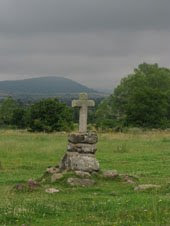The cloudy water with its orange tints of iron hid the small rocks on
 which the canoe immediately beached. A technique somewhere between pole-vaulting and pogo-ing propelled the boat further into the stream, so with burning muscles – those arm muscles which are rarely used during a year of walking - we began our next section of St Jack's route: boating on the Loire between Retournac and Bas-en-Basset. Just a couple of days' walk from Le Puy-en-Velay, we had reasoned that going by canoe still classed as going under our own steam; and with advice from the giggling tourist office staff in St-Bonnet-le-Chateau, we turned the idea’s germ into reality.
which the canoe immediately beached. A technique somewhere between pole-vaulting and pogo-ing propelled the boat further into the stream, so with burning muscles – those arm muscles which are rarely used during a year of walking - we began our next section of St Jack's route: boating on the Loire between Retournac and Bas-en-Basset. Just a couple of days' walk from Le Puy-en-Velay, we had reasoned that going by canoe still classed as going under our own steam; and with advice from the giggling tourist office staff in St-Bonnet-le-Chateau, we turned the idea’s germ into reality. Less than a minute later, flowing freely now with the current, the first boulders appeared from nowhere and hurtled against the pink plastic prow in front of me. We were pitched sideways, but a memory of canoeing was lodged in our hips and we instinctively leaned upstream till the canoe steadied and we could push and heave at solid water till we once again pointed downstream. Time for a quick assessment: rather too much water sloshing around our feet but otherwise no damage.
But already we were rushing into the next rapids and my arms were acting like slinky coils - great at stretching out but wobbly on the return. It crossed my mind to phone the canoe company to say we'd changed our minds and could they please pick us up next time they were passing?
Then deeper, slower water came just in time and we let the boat drift while we rested. To our right the high russet cliffs of the Gorges de la Loire rose free of their skirts of pine forests. To our left, on the concave bend, silt had formed meadows where, on this steamy Saturday, weekend fishermen
 stood silently.
stood silently.The sun broke through the early river-birthed fog and flashes of blue revealed, at long last, a French kingfisher at work. There were herons too, adults and juveniles, who stood chiseled against the water until at the last minute they dragged away like reluctant teenagers. Later, where the Gorges closed around us and all was forest, a bird of prey - perhaps a Milan Royal or Red Kite - remained petrified on its lookout as we passed underneath, gazing up at his pale throat and cocked eye.
The river didn't stay calm for long, of course. Every silent interlude pierced only by the mewling of the buzzards was followed by the rising chatter that turned to thunder as we came upon the next rapids. We remembered to paddle slowly as we approached, raking the view for hints of the line to take. Where did the reflected light seem to create the 'V' that would point the way? While looking for the farther boulders that just broke the surface we too often missed those lying under the near water, which threw us off our best-planned approaches. After choosing our line and steering - wonkily - towards it, we mostly ended up scraping the side of the biggest rocks and bucking violently in their lee. Which was how we learned to just go with it. Once you've lost control, the next best tactic is to
 let the canoe decide the line to take. Soon we were running the rapids like pros; my yelped swear words when I saw the size of the drop ahead seemed to help. Waves broke high over the front and into the boat; and twice we had to pull over to empty it. But the exhilaration was reward enough.
let the canoe decide the line to take. Soon we were running the rapids like pros; my yelped swear words when I saw the size of the drop ahead seemed to help. Waves broke high over the front and into the boat; and twice we had to pull over to empty it. But the exhilaration was reward enough.By the end of the day we had covered the twenty-one kilometers slightly faster than we would have walked them - but only slightly. So it was a relief we had decided on only one day of canoeing - our shoulders, lower backs and our bottoms are honed for just the one form of exertion this year.
28th July 2008





























































































